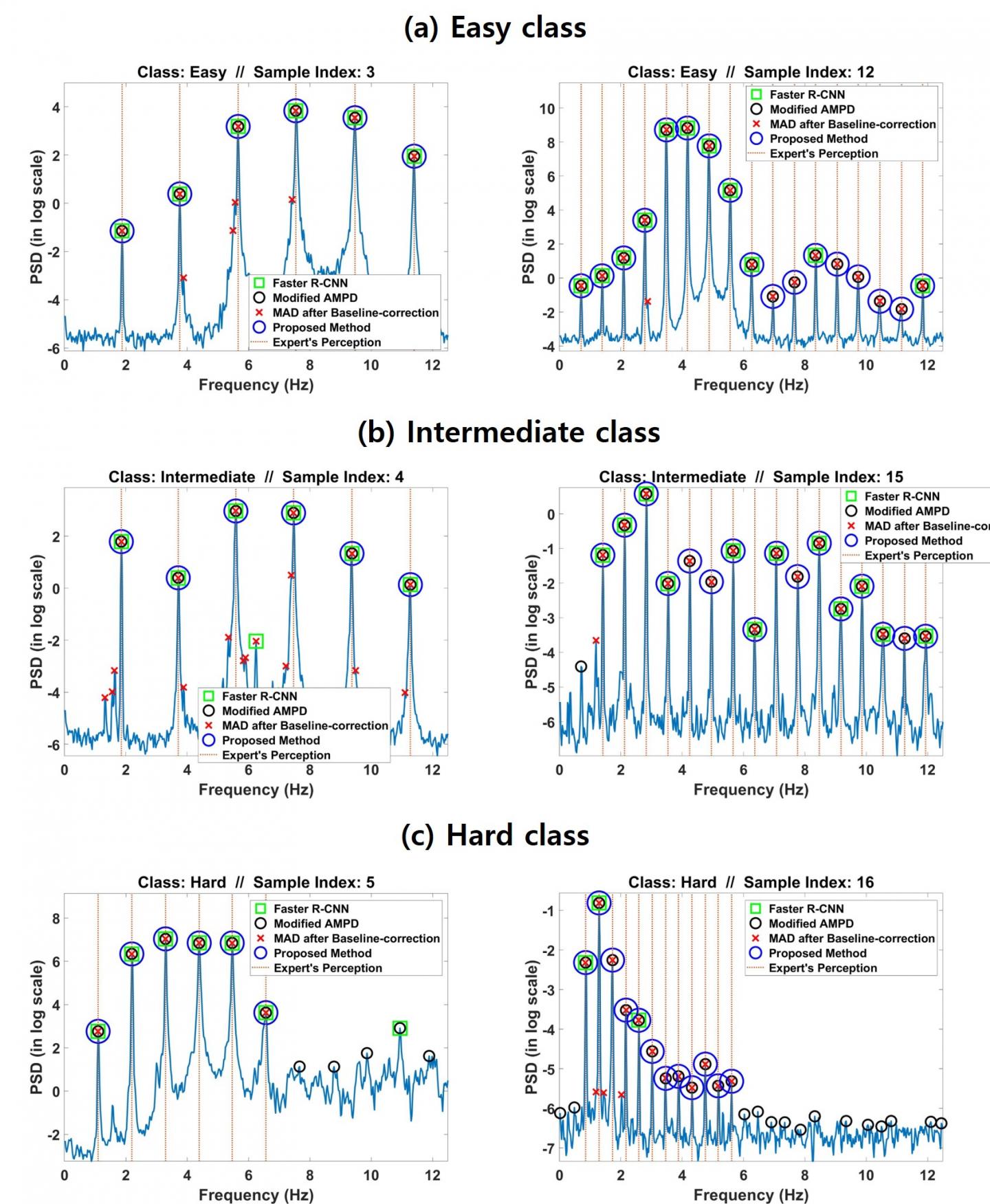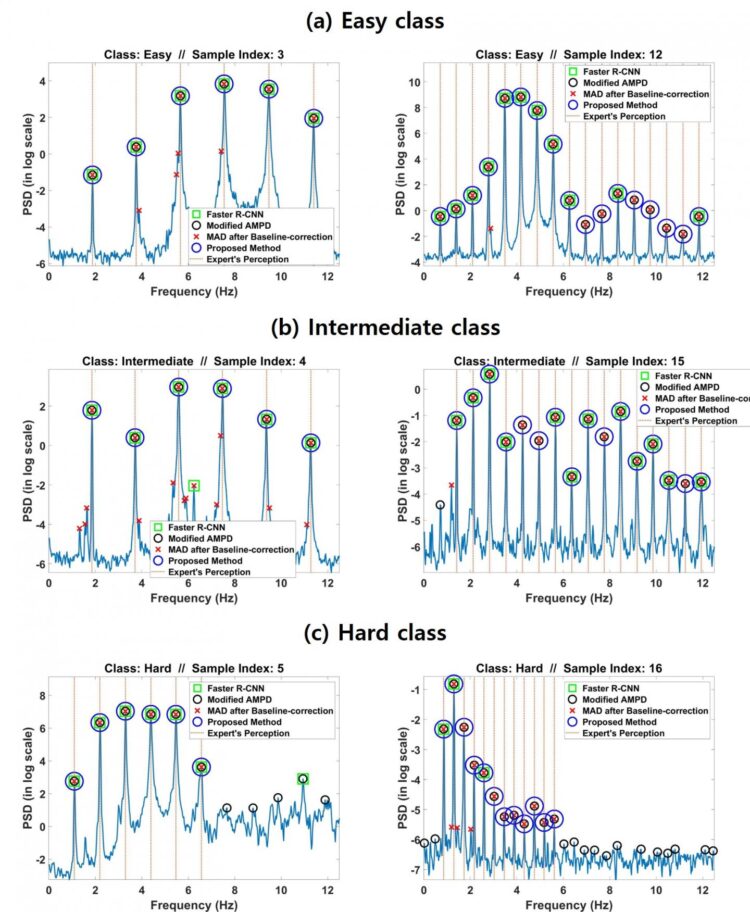Enjoying Domain Knowledge for stay-cable monitoring in full automation

Credit: Korea Institute of Civil Engineering and Building Technology (KICT)
The Korea Institute of Civil Engineering and Building Technology (KICT) has announced the development of a fully-automated peak-picking method for cable monitoring. The developed method will improve reliability of the method. Such as Incheon Bridge in South Korea, Cable-stayed bridges have received significant attention as efficient structural systems worldwide. In this regard, newly developed cable monitoring systems have become an essential and efficient maintenance approach for cable-stayed bridges. As structural integrity for stay-cables, tension force and damping ratio have been widely utilized as efficient metrics.
A research team in KICT, led by Dr. Seung-Seop Jin, has developed a fully-automated peak-picking method to extract the modal frequencies reliably and flexibly without any prior setting and human manipulation. The developed method utilizes the domain knowledge based on the physical characteristics of the stay-cables. It can be applied to any stay-cables irrespective of their physical characteristics. Consequently, it is fully-automated to estimate tension forces and damping ratio of any stay-cables.
For many years, vibration method has been widely adopted as a cost-effective method to monitor the stay-cables, since it does not require complicated device installation and its calibration. Since the vibration method simply installs the accelerometers in stay-cables, this method can apply to any stay-cables regardless of being in-service or built-in. Once the vibrational signal is measured by the accelerometer, this signal in time-domain is transformed into the Power Spectrum Density (PSD) in frequency domain. To estimate the tension force and damping ratio using vibration method, the modal frequencies (peaks in PSDs) are extracted via a peak-picking method.
Traditionally, a human manually performed peak-picking to select the modal frequencies. However, this method is vulnerable to operator’s bias, mistake and fatigue. In other words, human error occurs. As a result, it makes the manual peak-picking challenging for real-time and long-term monitoring. Several methods for automated peak-picking are implemented by selecting peaks larger than a predefined threshold values from the PSD, local maxima point a PSD within pre-defined frequency intervals, and peaks detected by deep-learning-based objective detection such as variants of Faster R-CNN and YOLO (hereafter referred to as “deep-learning method”).
However, these methods require human manipulation for predefined amplitude, frequency intervals and training process. In addition, their optimal setting is case-dependent. In this context, these methods cannot be considered as a fully-automated peak-picking method without any prior setting and human manipulation.
Dr. Jin said, “Stay-cables have remarkable physical characteristics. The modal frequencies of the stay-cables appear periodically or quasi-periodically with high-amplitudes. To enjoy the domain knowledge, we can find suitable methods from other disciplines. For example, our heart-beat makes periodic peaks in ECG signals and we can compute heart rate by counting the periodic peaks in real time. The biomedical discipline is one of the specialized fields for analyzing periodic peaks. We can adopt one of the methods from this discipline to exploit the periodic characteristics of the modal frequencies.”
When conceptualizing the developed method, the research team made several criteria to select the most suitable method from other disciplines. First, it does not require any hyper-parameters to be predefined by the user. Second, it should be fairly robust against noise and variabilities in signals. Third, their computational complexity and costs should be affordable for near real-time. Based on these three criteria, research team selected three algorithms from other disciplines, such as Bio and Brain Engineering, Raman Spectroscopy and Statistical Process Control. Since each method is developed based on the specific purpose of their original domain, the research team tailored them to accelerate research synergy.
The newly developed method was evaluated using real stay-cables in three cable-stayed bridges in South Korea (total 60 dataset). The proposed method compared with the deep-learning method extensively. The deep-learning method does not work well, when the characteristics of the real peaks differ from those of the peaks in the training data. The experimental results show that the developed method performs well regardless of the characteristics of the real PSD. Also, it outperforms state-of-art methods in terms of accuracy and robustness. And it does not need any prerequisites. Finally, its computational cost is very cheap (less than 0.5 seconds in standard personal computers) to be embedded into low-cost smart sensors.
Dr. Jin said, “For engineering, the most important ingredient is our domain knowledge. It can help us to define our problem and develop a proper solution. We will apply our method to other field-data for its generalization and improve it. Such iterative process is inherent and very important. We hope that our method can guide us to take a step towards autonomous monitoring systems.”
###
Korea Institute of Civil Engineering and Building Technology (KICT) is a government sponsored research institute established to contribute to the development of Korea’s construction industry and national economic growth by developing source and practical technology in the fields of construction and national land management.
This research project is funded by the National Research Foundation of Korea (NRF) grant funded by the Korea government (MSIT). (No. 2020R1C1C1009236). An article explaining the results of this research was published in Volume 126 of Automation in Construction, a renowned international journal in the ENGINEERING, CIVIL category (IF: 5.669, top 2.239% of JCR).
– Journal Paper
Jin et al. (2021), Fully automated peak-picking method for an autonomous stay-cable monitoring system in cable-stayed bridges, Automation in Construction, Vol. 126, 103628; https:/
Media Contact
Ahra, Cho
[email protected]
Related Journal Article
http://dx.





